Financial Decision Making
VerifiedAdded on 2023/06/10
|13
|3043
|357
AI Summary
This article discusses the importance of accurate costing in supporting the financial decision process. It compares traditional costing system and ABC system and determines the appropriate costing system for the airline sector. It also includes a journal entry on relevant costs.
Contribute Materials
Your contribution can guide someone’s learning journey. Share your
documents today.
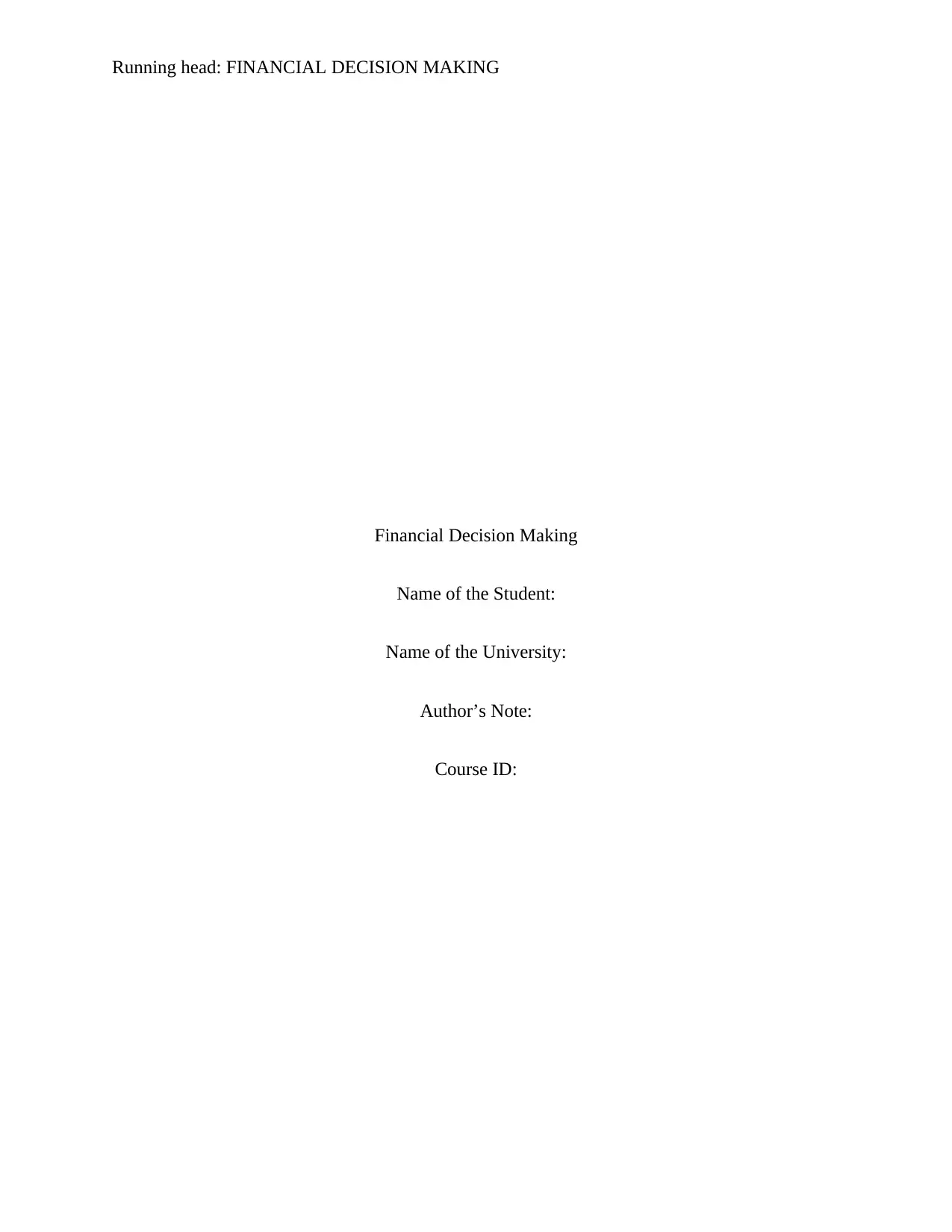
Running head: FINANCIAL DECISION MAKING
Financial Decision Making
Name of the Student:
Name of the University:
Author’s Note:
Course ID:
Financial Decision Making
Name of the Student:
Name of the University:
Author’s Note:
Course ID:
Secure Best Marks with AI Grader
Need help grading? Try our AI Grader for instant feedback on your assignments.
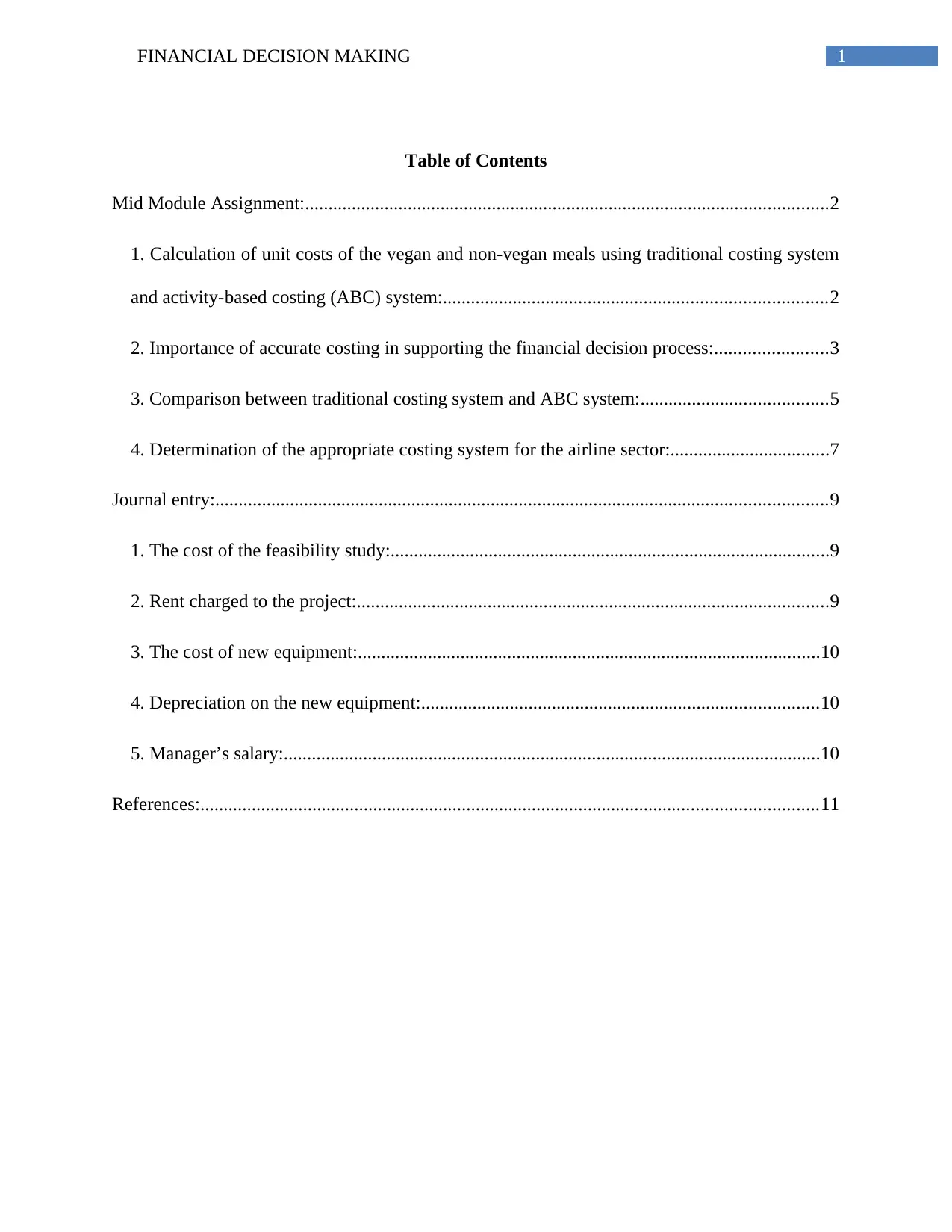
1FINANCIAL DECISION MAKING
Table of Contents
Mid Module Assignment:................................................................................................................2
1. Calculation of unit costs of the vegan and non-vegan meals using traditional costing system
and activity-based costing (ABC) system:..................................................................................2
2. Importance of accurate costing in supporting the financial decision process:........................3
3. Comparison between traditional costing system and ABC system:........................................5
4. Determination of the appropriate costing system for the airline sector:..................................7
Journal entry:...................................................................................................................................9
1. The cost of the feasibility study:..............................................................................................9
2. Rent charged to the project:.....................................................................................................9
3. The cost of new equipment:...................................................................................................10
4. Depreciation on the new equipment:.....................................................................................10
5. Manager’s salary:...................................................................................................................10
References:....................................................................................................................................11
Table of Contents
Mid Module Assignment:................................................................................................................2
1. Calculation of unit costs of the vegan and non-vegan meals using traditional costing system
and activity-based costing (ABC) system:..................................................................................2
2. Importance of accurate costing in supporting the financial decision process:........................3
3. Comparison between traditional costing system and ABC system:........................................5
4. Determination of the appropriate costing system for the airline sector:..................................7
Journal entry:...................................................................................................................................9
1. The cost of the feasibility study:..............................................................................................9
2. Rent charged to the project:.....................................................................................................9
3. The cost of new equipment:...................................................................................................10
4. Depreciation on the new equipment:.....................................................................................10
5. Manager’s salary:...................................................................................................................10
References:....................................................................................................................................11

2FINANCIAL DECISION MAKING
Mid Module Assignment:
1. Calculation of unit costs of the vegan and non-vegan meals using traditional costing
system and activity-based costing (ABC) system:
Computation of predetermined overhead rate:
Computation of unit cost under traditional costing system:
Computation of cost per driver under ABC system:
Computation of overhead cost per unit under ABC system:
Mid Module Assignment:
1. Calculation of unit costs of the vegan and non-vegan meals using traditional costing
system and activity-based costing (ABC) system:
Computation of predetermined overhead rate:
Computation of unit cost under traditional costing system:
Computation of cost per driver under ABC system:
Computation of overhead cost per unit under ABC system:
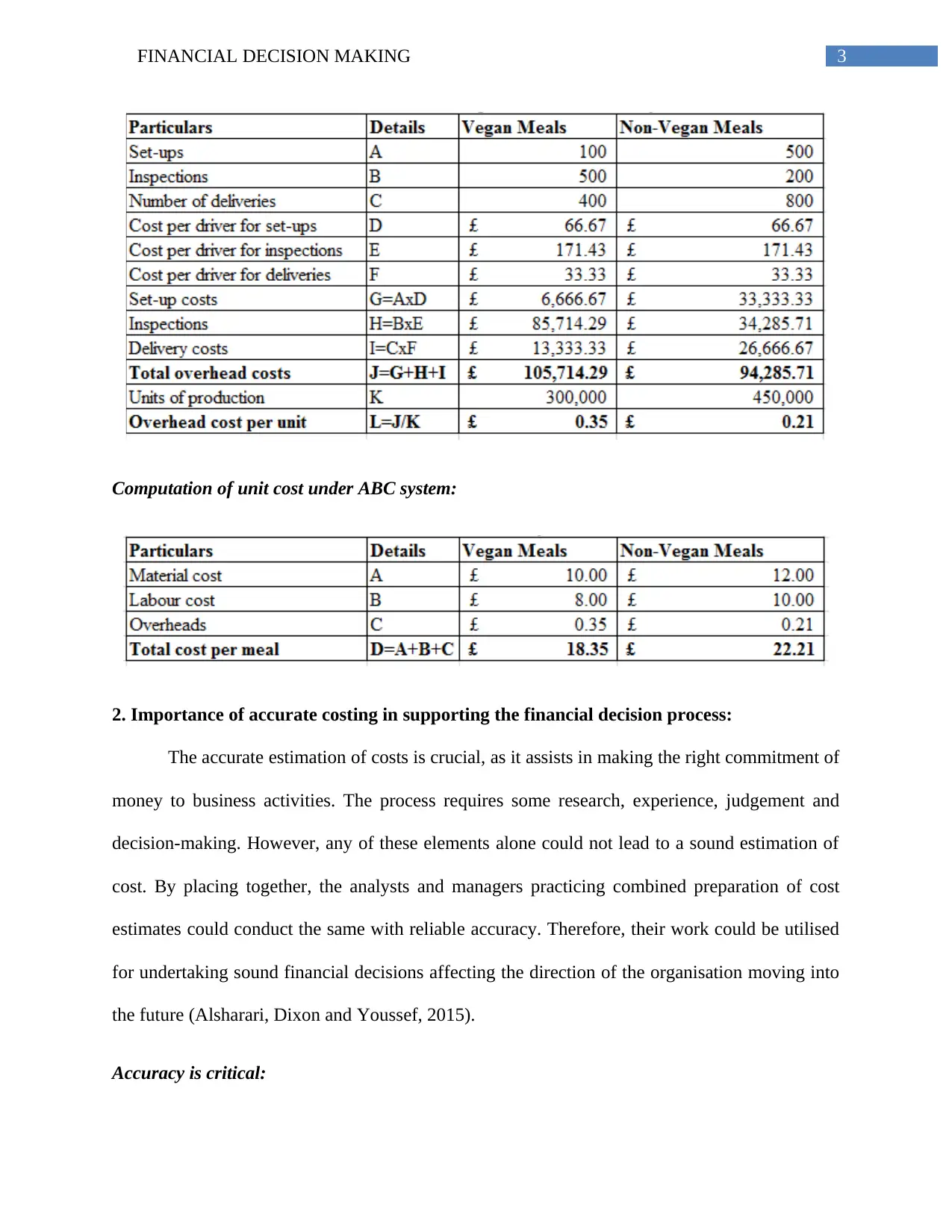
3FINANCIAL DECISION MAKING
Computation of unit cost under ABC system:
2. Importance of accurate costing in supporting the financial decision process:
The accurate estimation of costs is crucial, as it assists in making the right commitment of
money to business activities. The process requires some research, experience, judgement and
decision-making. However, any of these elements alone could not lead to a sound estimation of
cost. By placing together, the analysts and managers practicing combined preparation of cost
estimates could conduct the same with reliable accuracy. Therefore, their work could be utilised
for undertaking sound financial decisions affecting the direction of the organisation moving into
the future (Alsharari, Dixon and Youssef, 2015).
Accuracy is critical:
Computation of unit cost under ABC system:
2. Importance of accurate costing in supporting the financial decision process:
The accurate estimation of costs is crucial, as it assists in making the right commitment of
money to business activities. The process requires some research, experience, judgement and
decision-making. However, any of these elements alone could not lead to a sound estimation of
cost. By placing together, the analysts and managers practicing combined preparation of cost
estimates could conduct the same with reliable accuracy. Therefore, their work could be utilised
for undertaking sound financial decisions affecting the direction of the organisation moving into
the future (Alsharari, Dixon and Youssef, 2015).
Accuracy is critical:
Secure Best Marks with AI Grader
Need help grading? Try our AI Grader for instant feedback on your assignments.
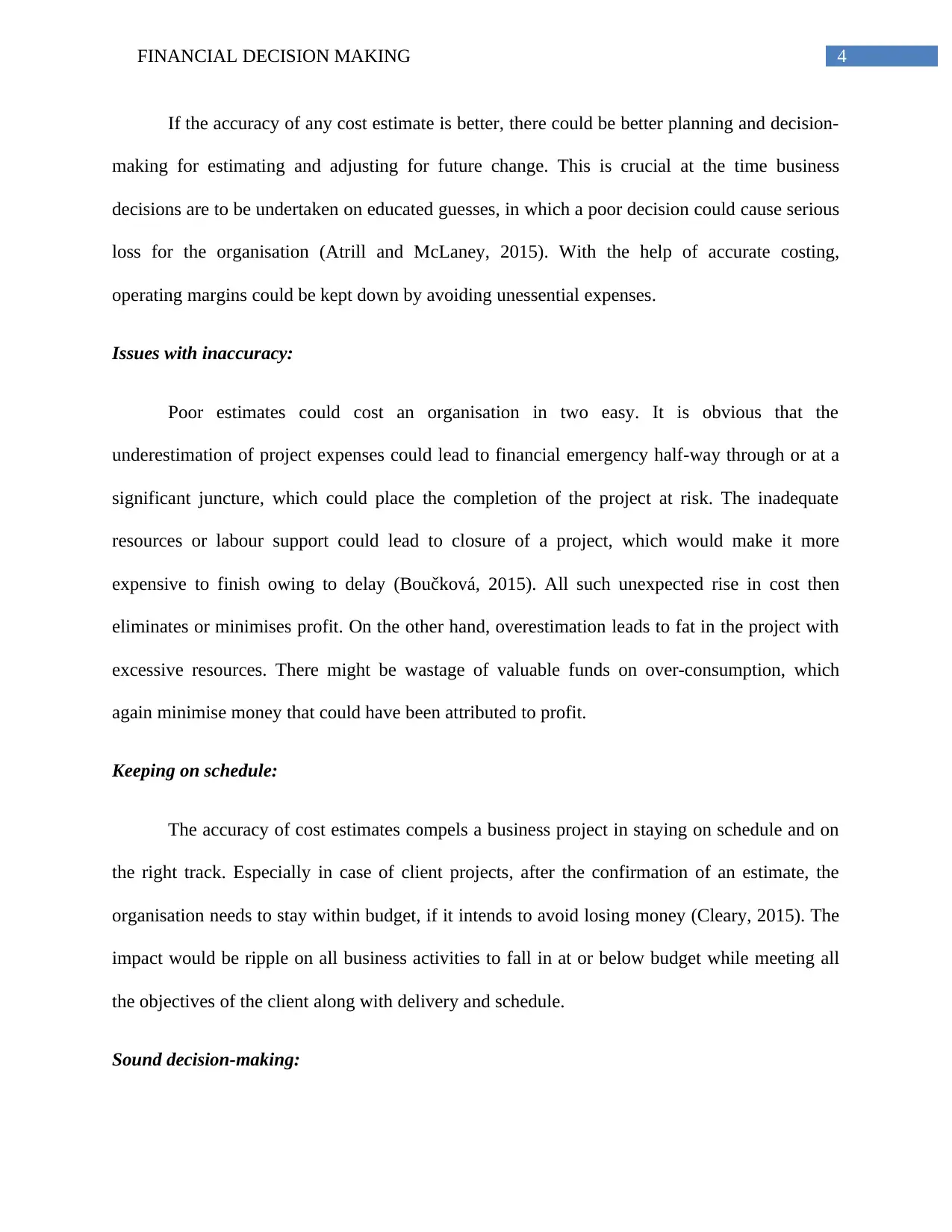
4FINANCIAL DECISION MAKING
If the accuracy of any cost estimate is better, there could be better planning and decision-
making for estimating and adjusting for future change. This is crucial at the time business
decisions are to be undertaken on educated guesses, in which a poor decision could cause serious
loss for the organisation (Atrill and McLaney, 2015). With the help of accurate costing,
operating margins could be kept down by avoiding unessential expenses.
Issues with inaccuracy:
Poor estimates could cost an organisation in two easy. It is obvious that the
underestimation of project expenses could lead to financial emergency half-way through or at a
significant juncture, which could place the completion of the project at risk. The inadequate
resources or labour support could lead to closure of a project, which would make it more
expensive to finish owing to delay (Boučková, 2015). All such unexpected rise in cost then
eliminates or minimises profit. On the other hand, overestimation leads to fat in the project with
excessive resources. There might be wastage of valuable funds on over-consumption, which
again minimise money that could have been attributed to profit.
Keeping on schedule:
The accuracy of cost estimates compels a business project in staying on schedule and on
the right track. Especially in case of client projects, after the confirmation of an estimate, the
organisation needs to stay within budget, if it intends to avoid losing money (Cleary, 2015). The
impact would be ripple on all business activities to fall in at or below budget while meeting all
the objectives of the client along with delivery and schedule.
Sound decision-making:
If the accuracy of any cost estimate is better, there could be better planning and decision-
making for estimating and adjusting for future change. This is crucial at the time business
decisions are to be undertaken on educated guesses, in which a poor decision could cause serious
loss for the organisation (Atrill and McLaney, 2015). With the help of accurate costing,
operating margins could be kept down by avoiding unessential expenses.
Issues with inaccuracy:
Poor estimates could cost an organisation in two easy. It is obvious that the
underestimation of project expenses could lead to financial emergency half-way through or at a
significant juncture, which could place the completion of the project at risk. The inadequate
resources or labour support could lead to closure of a project, which would make it more
expensive to finish owing to delay (Boučková, 2015). All such unexpected rise in cost then
eliminates or minimises profit. On the other hand, overestimation leads to fat in the project with
excessive resources. There might be wastage of valuable funds on over-consumption, which
again minimise money that could have been attributed to profit.
Keeping on schedule:
The accuracy of cost estimates compels a business project in staying on schedule and on
the right track. Especially in case of client projects, after the confirmation of an estimate, the
organisation needs to stay within budget, if it intends to avoid losing money (Cleary, 2015). The
impact would be ripple on all business activities to fall in at or below budget while meeting all
the objectives of the client along with delivery and schedule.
Sound decision-making:
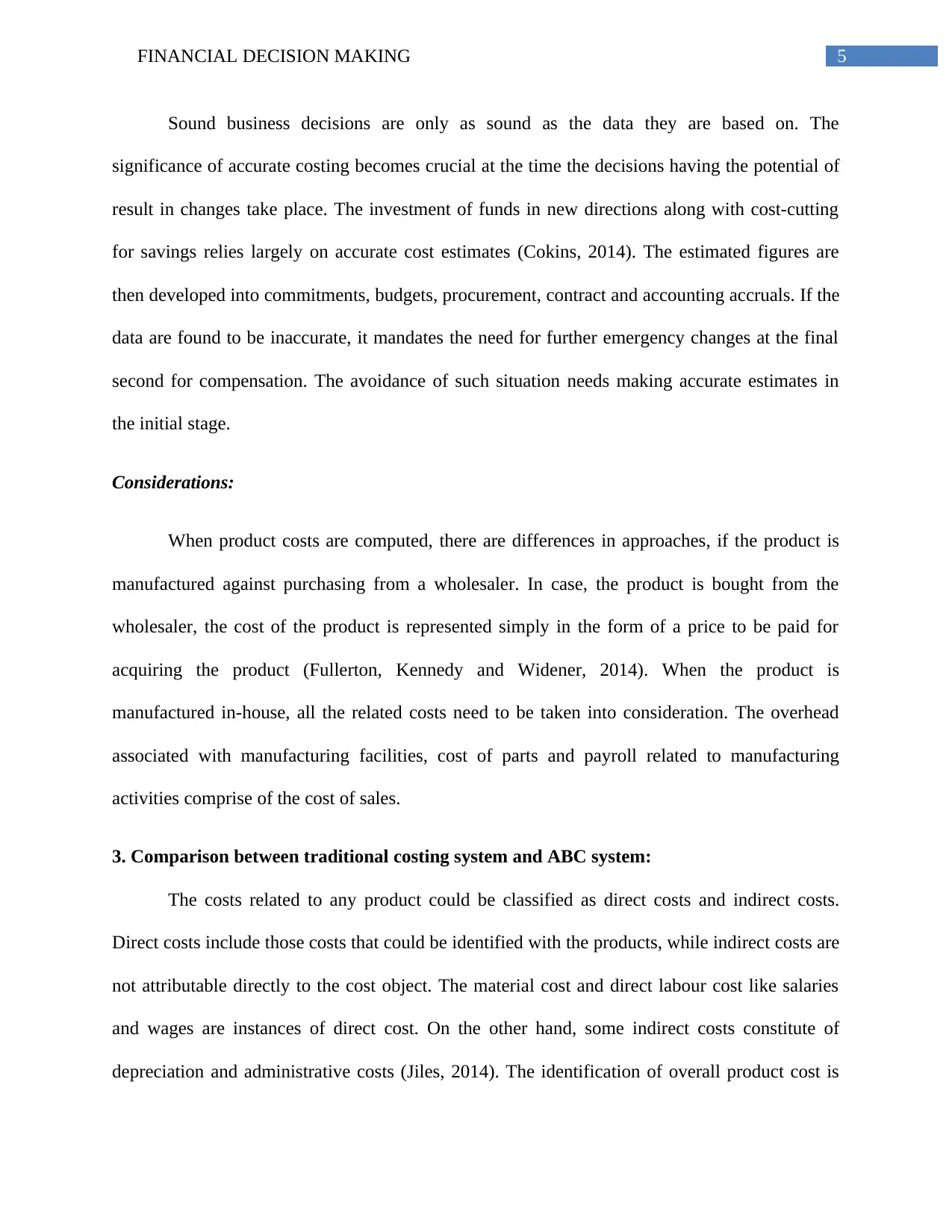
5FINANCIAL DECISION MAKING
Sound business decisions are only as sound as the data they are based on. The
significance of accurate costing becomes crucial at the time the decisions having the potential of
result in changes take place. The investment of funds in new directions along with cost-cutting
for savings relies largely on accurate cost estimates (Cokins, 2014). The estimated figures are
then developed into commitments, budgets, procurement, contract and accounting accruals. If the
data are found to be inaccurate, it mandates the need for further emergency changes at the final
second for compensation. The avoidance of such situation needs making accurate estimates in
the initial stage.
Considerations:
When product costs are computed, there are differences in approaches, if the product is
manufactured against purchasing from a wholesaler. In case, the product is bought from the
wholesaler, the cost of the product is represented simply in the form of a price to be paid for
acquiring the product (Fullerton, Kennedy and Widener, 2014). When the product is
manufactured in-house, all the related costs need to be taken into consideration. The overhead
associated with manufacturing facilities, cost of parts and payroll related to manufacturing
activities comprise of the cost of sales.
3. Comparison between traditional costing system and ABC system:
The costs related to any product could be classified as direct costs and indirect costs.
Direct costs include those costs that could be identified with the products, while indirect costs are
not attributable directly to the cost object. The material cost and direct labour cost like salaries
and wages are instances of direct cost. On the other hand, some indirect costs constitute of
depreciation and administrative costs (Jiles, 2014). The identification of overall product cost is
Sound business decisions are only as sound as the data they are based on. The
significance of accurate costing becomes crucial at the time the decisions having the potential of
result in changes take place. The investment of funds in new directions along with cost-cutting
for savings relies largely on accurate cost estimates (Cokins, 2014). The estimated figures are
then developed into commitments, budgets, procurement, contract and accounting accruals. If the
data are found to be inaccurate, it mandates the need for further emergency changes at the final
second for compensation. The avoidance of such situation needs making accurate estimates in
the initial stage.
Considerations:
When product costs are computed, there are differences in approaches, if the product is
manufactured against purchasing from a wholesaler. In case, the product is bought from the
wholesaler, the cost of the product is represented simply in the form of a price to be paid for
acquiring the product (Fullerton, Kennedy and Widener, 2014). When the product is
manufactured in-house, all the related costs need to be taken into consideration. The overhead
associated with manufacturing facilities, cost of parts and payroll related to manufacturing
activities comprise of the cost of sales.
3. Comparison between traditional costing system and ABC system:
The costs related to any product could be classified as direct costs and indirect costs.
Direct costs include those costs that could be identified with the products, while indirect costs are
not attributable directly to the cost object. The material cost and direct labour cost like salaries
and wages are instances of direct cost. On the other hand, some indirect costs constitute of
depreciation and administrative costs (Jiles, 2014). The identification of overall product cost is

6FINANCIAL DECISION MAKING
extremely significant in ascertaining the selling price of that product. The inaccurate cost
allocation might result in ascertainment of a selling price, which is lower than cost and this might
question the probability of the organisation. On some occasions, inaccurate cost ascertainment
might lead to higher product pricing compared to cost, which would result in loss of market
share. The total product cost changes with indirect cost allocation. The direct costs do not pose
issue, since they could be identifiable directly.
Traditional costing system:
In this costing system, the indirect costs are allocated depending on few common
allocation bases like machine hours and labour hours. The primary drawback of this method is
that it pools the indirect costs and they are assigned by utilising the allocation bases to the
departments (Juras, 2014). In majority of the cases, the method of allocation is not feasible, since
the indirect costs of all products of various stages are pooled. In this method, overheads are
assigned initially to the individual departments, after which the costs are reallocated to products.
Particularly, in the current era, this method loses its applicability, since a single organisation
manufactures various kinds of products by not using all departments. Therefore, the cost experts
have devised a new concept, which is activity-based costing (ABC) system. This is because the
system has reinforced the ongoing traditional costing system (Langfield-Smith et al. 2017).
Activity-based costing (ABC) system:
ABC system could be described as a costing approach, which identifies individual
activities like fundamental objects of cost. Under this system, the cost related to individual
activities are assigned in the initial stage and after that, it is utilised as the basis of allocating cost
to the ultimate objects of cost (Lavia López and Hiebl, 2014). This implies that under the ABC
extremely significant in ascertaining the selling price of that product. The inaccurate cost
allocation might result in ascertainment of a selling price, which is lower than cost and this might
question the probability of the organisation. On some occasions, inaccurate cost ascertainment
might lead to higher product pricing compared to cost, which would result in loss of market
share. The total product cost changes with indirect cost allocation. The direct costs do not pose
issue, since they could be identifiable directly.
Traditional costing system:
In this costing system, the indirect costs are allocated depending on few common
allocation bases like machine hours and labour hours. The primary drawback of this method is
that it pools the indirect costs and they are assigned by utilising the allocation bases to the
departments (Juras, 2014). In majority of the cases, the method of allocation is not feasible, since
the indirect costs of all products of various stages are pooled. In this method, overheads are
assigned initially to the individual departments, after which the costs are reallocated to products.
Particularly, in the current era, this method loses its applicability, since a single organisation
manufactures various kinds of products by not using all departments. Therefore, the cost experts
have devised a new concept, which is activity-based costing (ABC) system. This is because the
system has reinforced the ongoing traditional costing system (Langfield-Smith et al. 2017).
Activity-based costing (ABC) system:
ABC system could be described as a costing approach, which identifies individual
activities like fundamental objects of cost. Under this system, the cost related to individual
activities are assigned in the initial stage and after that, it is utilised as the basis of allocating cost
to the ultimate objects of cost (Lavia López and Hiebl, 2014). This implies that under the ABC
Paraphrase This Document
Need a fresh take? Get an instant paraphrase of this document with our AI Paraphraser
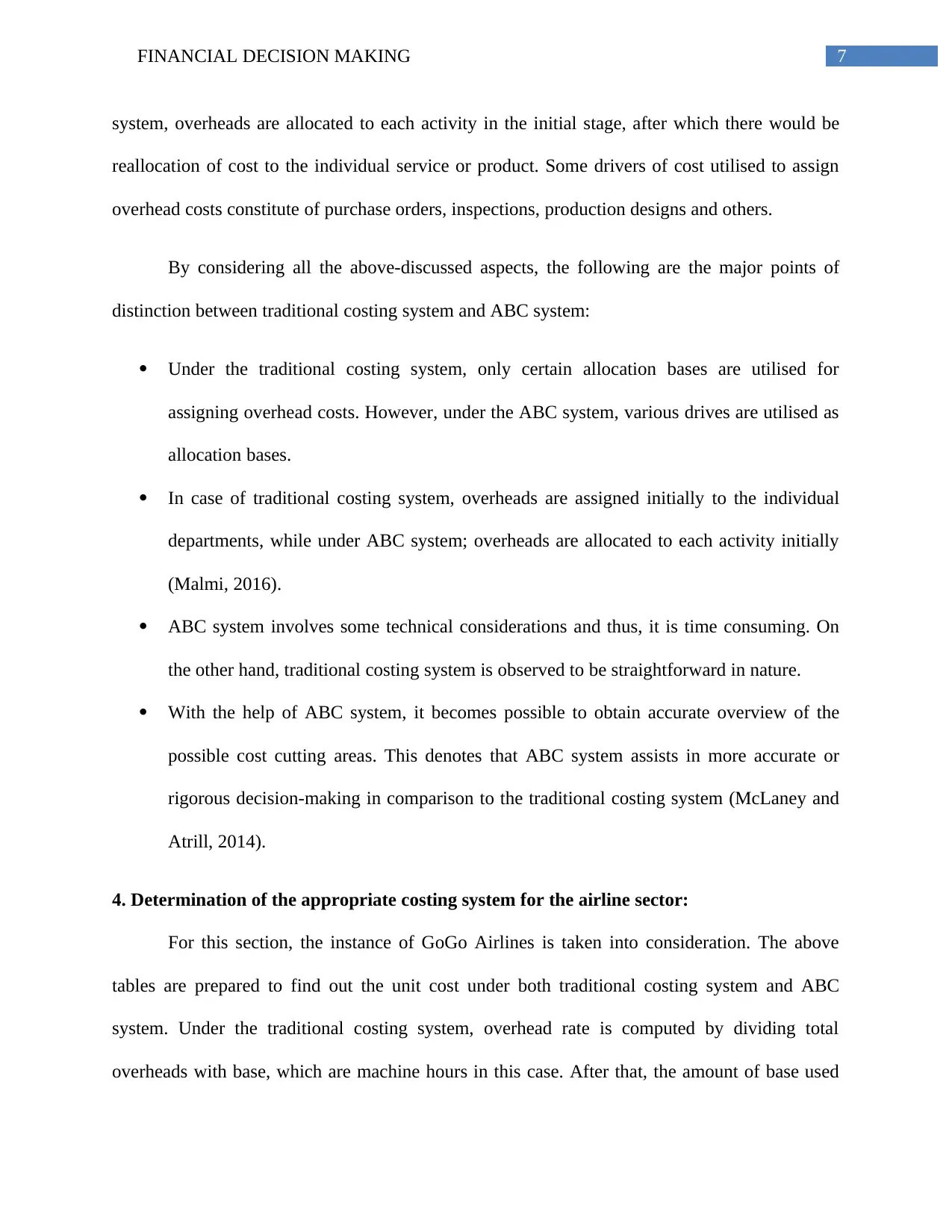
7FINANCIAL DECISION MAKING
system, overheads are allocated to each activity in the initial stage, after which there would be
reallocation of cost to the individual service or product. Some drivers of cost utilised to assign
overhead costs constitute of purchase orders, inspections, production designs and others.
By considering all the above-discussed aspects, the following are the major points of
distinction between traditional costing system and ABC system:
Under the traditional costing system, only certain allocation bases are utilised for
assigning overhead costs. However, under the ABC system, various drives are utilised as
allocation bases.
In case of traditional costing system, overheads are assigned initially to the individual
departments, while under ABC system; overheads are allocated to each activity initially
(Malmi, 2016).
ABC system involves some technical considerations and thus, it is time consuming. On
the other hand, traditional costing system is observed to be straightforward in nature.
With the help of ABC system, it becomes possible to obtain accurate overview of the
possible cost cutting areas. This denotes that ABC system assists in more accurate or
rigorous decision-making in comparison to the traditional costing system (McLaney and
Atrill, 2014).
4. Determination of the appropriate costing system for the airline sector:
For this section, the instance of GoGo Airlines is taken into consideration. The above
tables are prepared to find out the unit cost under both traditional costing system and ABC
system. Under the traditional costing system, overhead rate is computed by dividing total
overheads with base, which are machine hours in this case. After that, the amount of base used
system, overheads are allocated to each activity in the initial stage, after which there would be
reallocation of cost to the individual service or product. Some drivers of cost utilised to assign
overhead costs constitute of purchase orders, inspections, production designs and others.
By considering all the above-discussed aspects, the following are the major points of
distinction between traditional costing system and ABC system:
Under the traditional costing system, only certain allocation bases are utilised for
assigning overhead costs. However, under the ABC system, various drives are utilised as
allocation bases.
In case of traditional costing system, overheads are assigned initially to the individual
departments, while under ABC system; overheads are allocated to each activity initially
(Malmi, 2016).
ABC system involves some technical considerations and thus, it is time consuming. On
the other hand, traditional costing system is observed to be straightforward in nature.
With the help of ABC system, it becomes possible to obtain accurate overview of the
possible cost cutting areas. This denotes that ABC system assists in more accurate or
rigorous decision-making in comparison to the traditional costing system (McLaney and
Atrill, 2014).
4. Determination of the appropriate costing system for the airline sector:
For this section, the instance of GoGo Airlines is taken into consideration. The above
tables are prepared to find out the unit cost under both traditional costing system and ABC
system. Under the traditional costing system, overhead rate is computed by dividing total
overheads with base, which are machine hours in this case. After that, the amount of base used
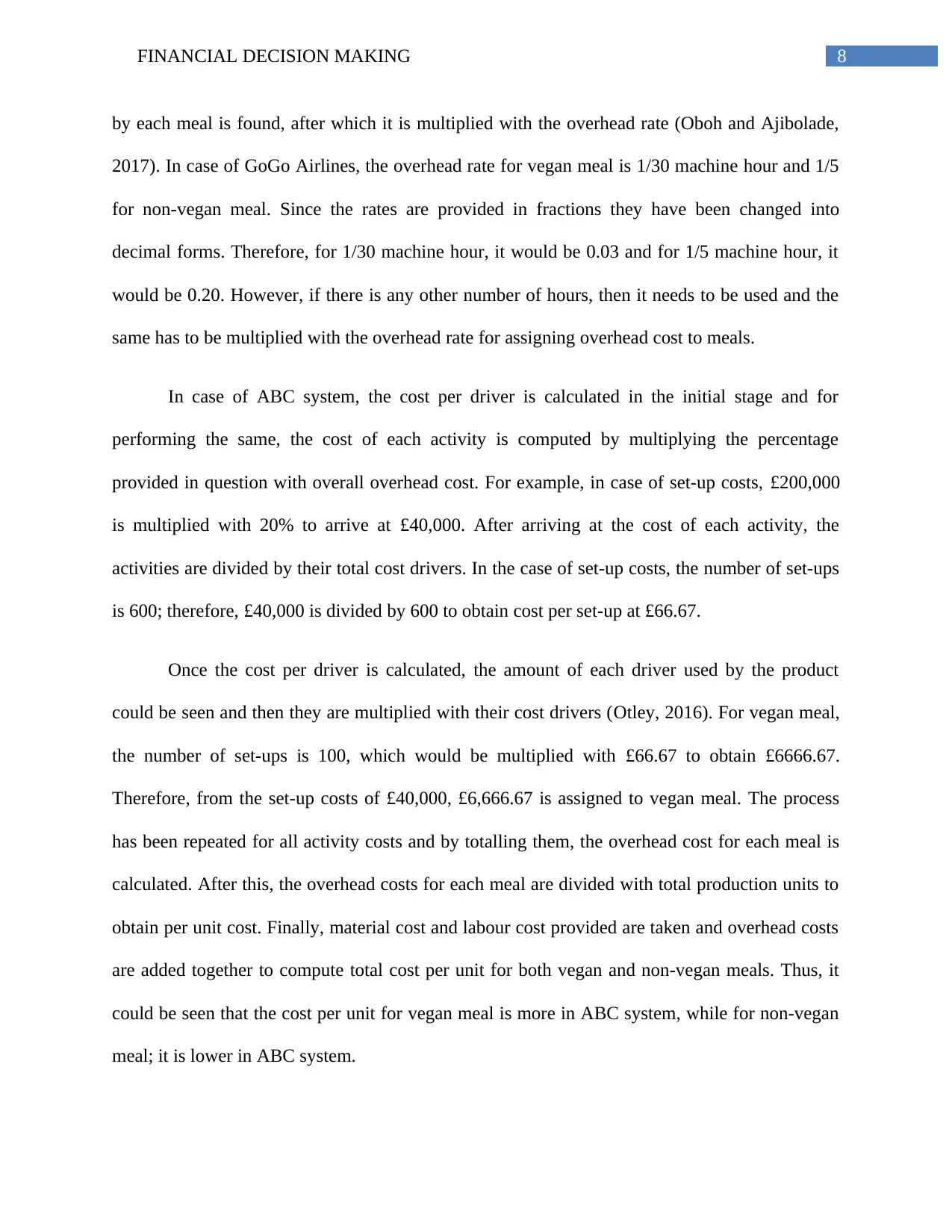
8FINANCIAL DECISION MAKING
by each meal is found, after which it is multiplied with the overhead rate (Oboh and Ajibolade,
2017). In case of GoGo Airlines, the overhead rate for vegan meal is 1/30 machine hour and 1/5
for non-vegan meal. Since the rates are provided in fractions they have been changed into
decimal forms. Therefore, for 1/30 machine hour, it would be 0.03 and for 1/5 machine hour, it
would be 0.20. However, if there is any other number of hours, then it needs to be used and the
same has to be multiplied with the overhead rate for assigning overhead cost to meals.
In case of ABC system, the cost per driver is calculated in the initial stage and for
performing the same, the cost of each activity is computed by multiplying the percentage
provided in question with overall overhead cost. For example, in case of set-up costs, £200,000
is multiplied with 20% to arrive at £40,000. After arriving at the cost of each activity, the
activities are divided by their total cost drivers. In the case of set-up costs, the number of set-ups
is 600; therefore, £40,000 is divided by 600 to obtain cost per set-up at £66.67.
Once the cost per driver is calculated, the amount of each driver used by the product
could be seen and then they are multiplied with their cost drivers (Otley, 2016). For vegan meal,
the number of set-ups is 100, which would be multiplied with £66.67 to obtain £6666.67.
Therefore, from the set-up costs of £40,000, £6,666.67 is assigned to vegan meal. The process
has been repeated for all activity costs and by totalling them, the overhead cost for each meal is
calculated. After this, the overhead costs for each meal are divided with total production units to
obtain per unit cost. Finally, material cost and labour cost provided are taken and overhead costs
are added together to compute total cost per unit for both vegan and non-vegan meals. Thus, it
could be seen that the cost per unit for vegan meal is more in ABC system, while for non-vegan
meal; it is lower in ABC system.
by each meal is found, after which it is multiplied with the overhead rate (Oboh and Ajibolade,
2017). In case of GoGo Airlines, the overhead rate for vegan meal is 1/30 machine hour and 1/5
for non-vegan meal. Since the rates are provided in fractions they have been changed into
decimal forms. Therefore, for 1/30 machine hour, it would be 0.03 and for 1/5 machine hour, it
would be 0.20. However, if there is any other number of hours, then it needs to be used and the
same has to be multiplied with the overhead rate for assigning overhead cost to meals.
In case of ABC system, the cost per driver is calculated in the initial stage and for
performing the same, the cost of each activity is computed by multiplying the percentage
provided in question with overall overhead cost. For example, in case of set-up costs, £200,000
is multiplied with 20% to arrive at £40,000. After arriving at the cost of each activity, the
activities are divided by their total cost drivers. In the case of set-up costs, the number of set-ups
is 600; therefore, £40,000 is divided by 600 to obtain cost per set-up at £66.67.
Once the cost per driver is calculated, the amount of each driver used by the product
could be seen and then they are multiplied with their cost drivers (Otley, 2016). For vegan meal,
the number of set-ups is 100, which would be multiplied with £66.67 to obtain £6666.67.
Therefore, from the set-up costs of £40,000, £6,666.67 is assigned to vegan meal. The process
has been repeated for all activity costs and by totalling them, the overhead cost for each meal is
calculated. After this, the overhead costs for each meal are divided with total production units to
obtain per unit cost. Finally, material cost and labour cost provided are taken and overhead costs
are added together to compute total cost per unit for both vegan and non-vegan meals. Thus, it
could be seen that the cost per unit for vegan meal is more in ABC system, while for non-vegan
meal; it is lower in ABC system.
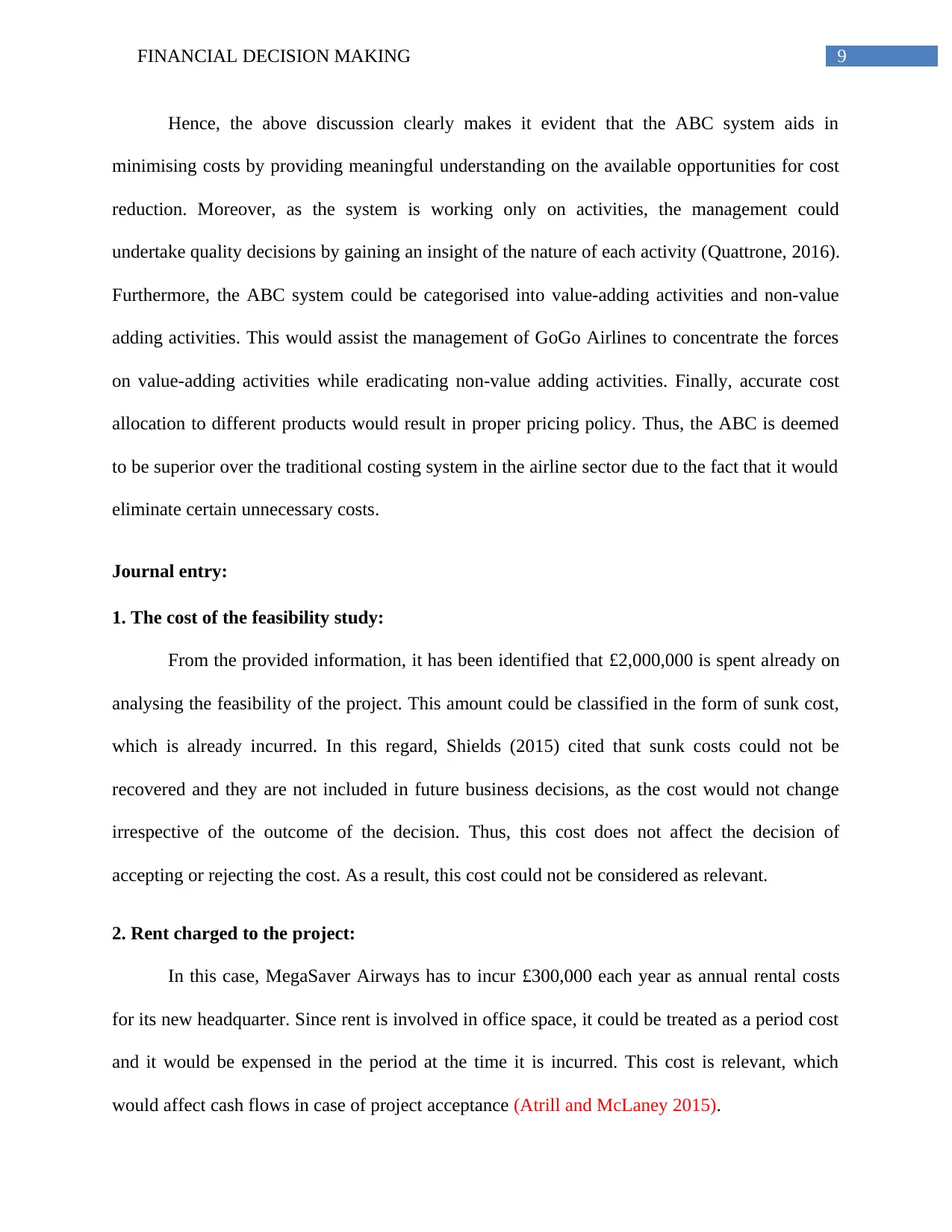
9FINANCIAL DECISION MAKING
Hence, the above discussion clearly makes it evident that the ABC system aids in
minimising costs by providing meaningful understanding on the available opportunities for cost
reduction. Moreover, as the system is working only on activities, the management could
undertake quality decisions by gaining an insight of the nature of each activity (Quattrone, 2016).
Furthermore, the ABC system could be categorised into value-adding activities and non-value
adding activities. This would assist the management of GoGo Airlines to concentrate the forces
on value-adding activities while eradicating non-value adding activities. Finally, accurate cost
allocation to different products would result in proper pricing policy. Thus, the ABC is deemed
to be superior over the traditional costing system in the airline sector due to the fact that it would
eliminate certain unnecessary costs.
Journal entry:
1. The cost of the feasibility study:
From the provided information, it has been identified that £2,000,000 is spent already on
analysing the feasibility of the project. This amount could be classified in the form of sunk cost,
which is already incurred. In this regard, Shields (2015) cited that sunk costs could not be
recovered and they are not included in future business decisions, as the cost would not change
irrespective of the outcome of the decision. Thus, this cost does not affect the decision of
accepting or rejecting the cost. As a result, this cost could not be considered as relevant.
2. Rent charged to the project:
In this case, MegaSaver Airways has to incur £300,000 each year as annual rental costs
for its new headquarter. Since rent is involved in office space, it could be treated as a period cost
and it would be expensed in the period at the time it is incurred. This cost is relevant, which
would affect cash flows in case of project acceptance (Atrill and McLaney 2015).
Hence, the above discussion clearly makes it evident that the ABC system aids in
minimising costs by providing meaningful understanding on the available opportunities for cost
reduction. Moreover, as the system is working only on activities, the management could
undertake quality decisions by gaining an insight of the nature of each activity (Quattrone, 2016).
Furthermore, the ABC system could be categorised into value-adding activities and non-value
adding activities. This would assist the management of GoGo Airlines to concentrate the forces
on value-adding activities while eradicating non-value adding activities. Finally, accurate cost
allocation to different products would result in proper pricing policy. Thus, the ABC is deemed
to be superior over the traditional costing system in the airline sector due to the fact that it would
eliminate certain unnecessary costs.
Journal entry:
1. The cost of the feasibility study:
From the provided information, it has been identified that £2,000,000 is spent already on
analysing the feasibility of the project. This amount could be classified in the form of sunk cost,
which is already incurred. In this regard, Shields (2015) cited that sunk costs could not be
recovered and they are not included in future business decisions, as the cost would not change
irrespective of the outcome of the decision. Thus, this cost does not affect the decision of
accepting or rejecting the cost. As a result, this cost could not be considered as relevant.
2. Rent charged to the project:
In this case, MegaSaver Airways has to incur £300,000 each year as annual rental costs
for its new headquarter. Since rent is involved in office space, it could be treated as a period cost
and it would be expensed in the period at the time it is incurred. This cost is relevant, which
would affect cash flows in case of project acceptance (Atrill and McLaney 2015).
Secure Best Marks with AI Grader
Need help grading? Try our AI Grader for instant feedback on your assignments.

10FINANCIAL DECISION MAKING
3. The cost of new equipment:
As per the provided information, new equipment needs to be purchased at £1,500,000.
This cost is deemed to be relevant, as the impact would be on the initial cash flows; in case, the
project is accepted.
4. Depreciation on the new equipment:
Since the new equipment is to be depreciated on straight-line basis for ten years,
MegaSaver Airways has to incur £150,000 as depreciation expense per year (£1,500,000/10
years). This is a relevant cost, since it would generate positive yearly cash flow as annual
depreciation tax shield.
5. Manager’s salary:
The salary of the manager, which is £100,000, is a relevant opportunity cost. In case; the
project is not undertaken, 25% of the manager’s time could be used in other business activities.
3. The cost of new equipment:
As per the provided information, new equipment needs to be purchased at £1,500,000.
This cost is deemed to be relevant, as the impact would be on the initial cash flows; in case, the
project is accepted.
4. Depreciation on the new equipment:
Since the new equipment is to be depreciated on straight-line basis for ten years,
MegaSaver Airways has to incur £150,000 as depreciation expense per year (£1,500,000/10
years). This is a relevant cost, since it would generate positive yearly cash flow as annual
depreciation tax shield.
5. Manager’s salary:
The salary of the manager, which is £100,000, is a relevant opportunity cost. In case; the
project is not undertaken, 25% of the manager’s time could be used in other business activities.
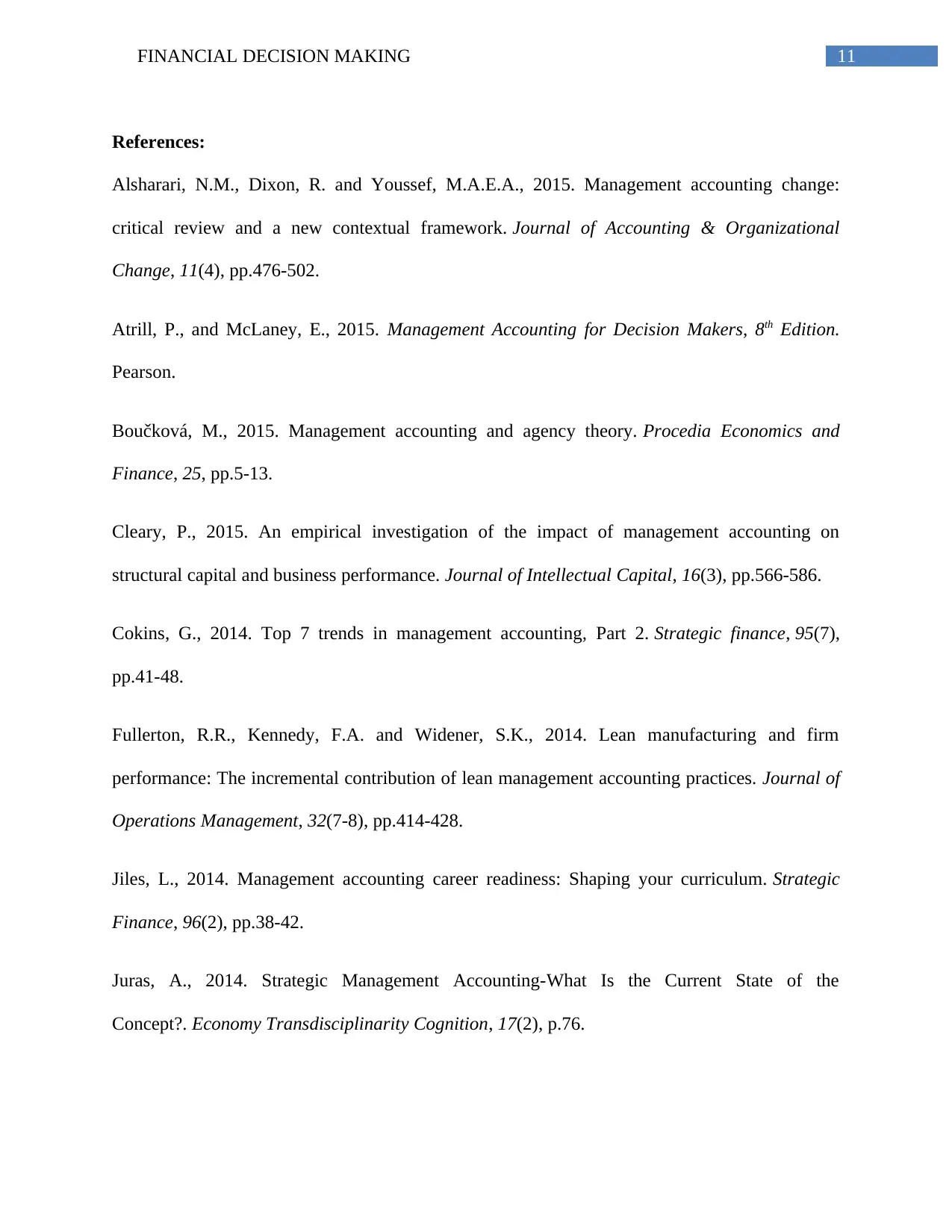
11FINANCIAL DECISION MAKING
References:
Alsharari, N.M., Dixon, R. and Youssef, M.A.E.A., 2015. Management accounting change:
critical review and a new contextual framework. Journal of Accounting & Organizational
Change, 11(4), pp.476-502.
Atrill, P., and McLaney, E., 2015. Management Accounting for Decision Makers, 8th Edition.
Pearson.
Boučková, M., 2015. Management accounting and agency theory. Procedia Economics and
Finance, 25, pp.5-13.
Cleary, P., 2015. An empirical investigation of the impact of management accounting on
structural capital and business performance. Journal of Intellectual Capital, 16(3), pp.566-586.
Cokins, G., 2014. Top 7 trends in management accounting, Part 2. Strategic finance, 95(7),
pp.41-48.
Fullerton, R.R., Kennedy, F.A. and Widener, S.K., 2014. Lean manufacturing and firm
performance: The incremental contribution of lean management accounting practices. Journal of
Operations Management, 32(7-8), pp.414-428.
Jiles, L., 2014. Management accounting career readiness: Shaping your curriculum. Strategic
Finance, 96(2), pp.38-42.
Juras, A., 2014. Strategic Management Accounting-What Is the Current State of the
Concept?. Economy Transdisciplinarity Cognition, 17(2), p.76.
References:
Alsharari, N.M., Dixon, R. and Youssef, M.A.E.A., 2015. Management accounting change:
critical review and a new contextual framework. Journal of Accounting & Organizational
Change, 11(4), pp.476-502.
Atrill, P., and McLaney, E., 2015. Management Accounting for Decision Makers, 8th Edition.
Pearson.
Boučková, M., 2015. Management accounting and agency theory. Procedia Economics and
Finance, 25, pp.5-13.
Cleary, P., 2015. An empirical investigation of the impact of management accounting on
structural capital and business performance. Journal of Intellectual Capital, 16(3), pp.566-586.
Cokins, G., 2014. Top 7 trends in management accounting, Part 2. Strategic finance, 95(7),
pp.41-48.
Fullerton, R.R., Kennedy, F.A. and Widener, S.K., 2014. Lean manufacturing and firm
performance: The incremental contribution of lean management accounting practices. Journal of
Operations Management, 32(7-8), pp.414-428.
Jiles, L., 2014. Management accounting career readiness: Shaping your curriculum. Strategic
Finance, 96(2), pp.38-42.
Juras, A., 2014. Strategic Management Accounting-What Is the Current State of the
Concept?. Economy Transdisciplinarity Cognition, 17(2), p.76.
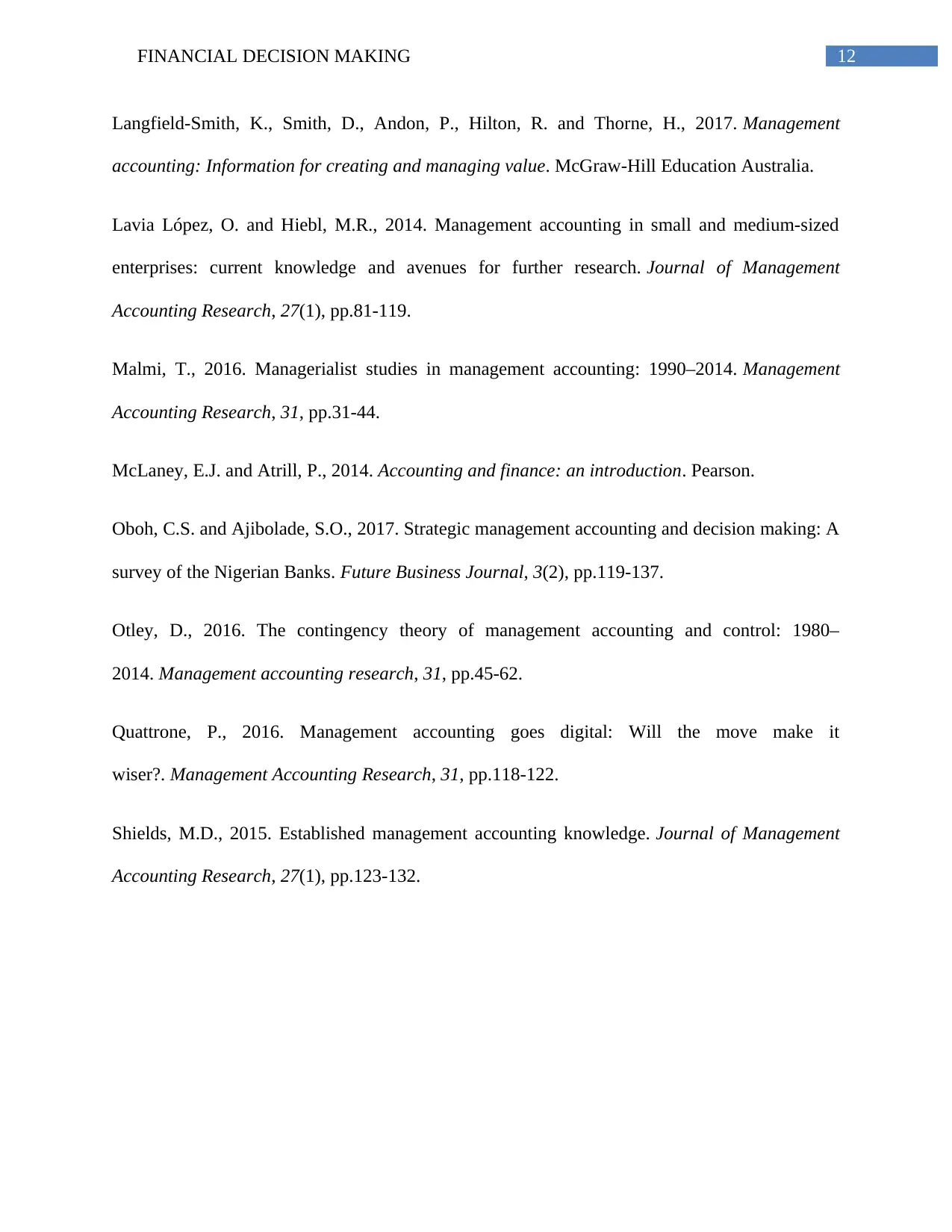
12FINANCIAL DECISION MAKING
Langfield-Smith, K., Smith, D., Andon, P., Hilton, R. and Thorne, H., 2017. Management
accounting: Information for creating and managing value. McGraw-Hill Education Australia.
Lavia López, O. and Hiebl, M.R., 2014. Management accounting in small and medium-sized
enterprises: current knowledge and avenues for further research. Journal of Management
Accounting Research, 27(1), pp.81-119.
Malmi, T., 2016. Managerialist studies in management accounting: 1990–2014. Management
Accounting Research, 31, pp.31-44.
McLaney, E.J. and Atrill, P., 2014. Accounting and finance: an introduction. Pearson.
Oboh, C.S. and Ajibolade, S.O., 2017. Strategic management accounting and decision making: A
survey of the Nigerian Banks. Future Business Journal, 3(2), pp.119-137.
Otley, D., 2016. The contingency theory of management accounting and control: 1980–
2014. Management accounting research, 31, pp.45-62.
Quattrone, P., 2016. Management accounting goes digital: Will the move make it
wiser?. Management Accounting Research, 31, pp.118-122.
Shields, M.D., 2015. Established management accounting knowledge. Journal of Management
Accounting Research, 27(1), pp.123-132.
Langfield-Smith, K., Smith, D., Andon, P., Hilton, R. and Thorne, H., 2017. Management
accounting: Information for creating and managing value. McGraw-Hill Education Australia.
Lavia López, O. and Hiebl, M.R., 2014. Management accounting in small and medium-sized
enterprises: current knowledge and avenues for further research. Journal of Management
Accounting Research, 27(1), pp.81-119.
Malmi, T., 2016. Managerialist studies in management accounting: 1990–2014. Management
Accounting Research, 31, pp.31-44.
McLaney, E.J. and Atrill, P., 2014. Accounting and finance: an introduction. Pearson.
Oboh, C.S. and Ajibolade, S.O., 2017. Strategic management accounting and decision making: A
survey of the Nigerian Banks. Future Business Journal, 3(2), pp.119-137.
Otley, D., 2016. The contingency theory of management accounting and control: 1980–
2014. Management accounting research, 31, pp.45-62.
Quattrone, P., 2016. Management accounting goes digital: Will the move make it
wiser?. Management Accounting Research, 31, pp.118-122.
Shields, M.D., 2015. Established management accounting knowledge. Journal of Management
Accounting Research, 27(1), pp.123-132.
1 out of 13
Related Documents
Your All-in-One AI-Powered Toolkit for Academic Success.
+13062052269
info@desklib.com
Available 24*7 on WhatsApp / Email
![[object Object]](/_next/static/media/star-bottom.7253800d.svg)
Unlock your academic potential
© 2024 | Zucol Services PVT LTD | All rights reserved.





